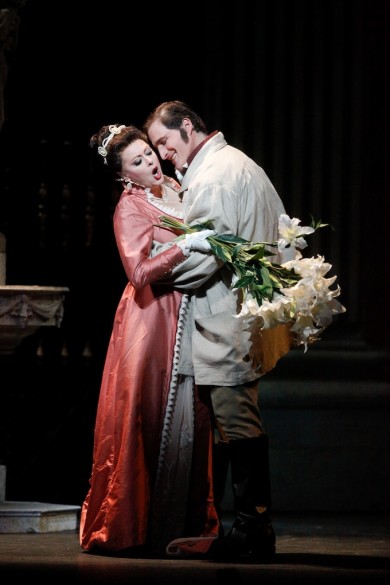Aprea and orchestra are the stars in Palm Beach Opera’s effective, well-sung “Tosca”

Chiara Taigi and Riccardo Massi in Palm Beach Opera's production of Puccini's "Tosca."
When Palm Beach Opera artistic director Bruno Aprea strode into the pit Friday evening to lead the second act of Tosca, there wasn’t just applause from the Kravis Center audience. There were cheers.
Aprea and the orchestra were the biggest stars of this finely paced, tension-filled performance, giving a darkly lustrous account of Puccini’s score.
There were other highlights as well. The hefty voice of soprano Chiara Taigi brought an unaccustomed depth and worldliness to the role of the renowned singer Floria Tosca. Sets and direction were traditional and effective, with realistic portrayals of the church interior, police chief’s office and ancient Roman castle in which the desperate final actions of Tosca’s life took place.
But it was Aprea and the orchestra that were the most consistently effective element of the production. In this core work of the Italian repertoire, orchestra and conductor were entirely in their element. With the exception of some out-of-tune solo string playing just before the third-act tenor aria E lucevan le stelle, the playing was technically immaculate. There were many great moments: the ominous flute playing as Scarpia threatens Tosca and Cavaradossi, the dark twisted sounds that accompany the police chief’s scheming in Act 1, the grinding, tension-filled passages as the torturers work on Cavaradossi.
Fittingly, the role of Tosca was taken by a native of the city of Rome. Chiara Taigi’s rich soprano and subtle acting gave Tosca unusual depth and maturity. Rather than engaging in a succession of over-the-top, jealous diva poses, she gave a realistic – within the bounds of the art form – portrait of a woman of warmth, emotional turmoil and frantic courage. Her singing wasn’t always even or accurate, particularly in the first act, as she berates Cavaradossi about the beautiful blonde woman in his church painting. But her Vissi d’arte was a moving, breathing and emotionally committed performance. Her murder of Scarpia, rather than being a moment for shrieking dramatics, was creepily intimate as she murmured to him to die.
As Scarpia the baritone Claudio Sgura gave an account that avoided some of the leering and smirking that sometimes accompanies portrayals of this arch-villain. His Scarpia was a portrait of aristocratic evil. As he walked slowly back and forth before Cavaradossi, held prisoner in his office, he was clearly a man who held all the cards and didn’t have to strain to intimidate. Vocally, as he revealed in the Te Deum and elsewhere, he was less impressive, with his tone tending to get lost in a baritonal fog of low sounds, often drowned out by the orchestra.
The young Italian tenor Riccardo Massi brought a commanding physical presence and full-bodied, accurate and even-toned voice to the role of the artist Cavaradossi. But he tended to hold back emotionally. While there was nothing wrong vocally with his E lucevan le stelle, it was too pristine, with none of the desperate edge of man facing death. It seemed more like a performance at a vocal recital than at an opera.
The sets, originally designed for Sarasota Opera, were clearly too small for the vast stage at the Kravis Center, requiring black backdrops at both ends of the stage to reach the wings. They provided no surprises to anyone familiar with the opera, except for the starkly dramatic battlements of the Castel Sant’Angelo, with a winged gargoyle and moonlit sky.
Stage direction by Massimo Gasparon was traditional and naturalistic, with no attention-grabbing stunts to hype the dramatics. The Te Deum, in which Scarpia growls his plans for Tosca as a church service gets underway, was the theatrical show-stopper it was intended to be, with a procession of church officials and candle-bearing altar boys, wreathed in incense smoke.
“Please be advised that in Act 3 there are loud gunshots,” warned a sign on the supertitle screen during the final intermission. While presumably posted in deference to some of the weak hearts in the audience, the sign should have warned of a more irritating noise: As the guard walked along the ledge of the Castel Sant’Angelo, going slowly up and down a few steps, they creaked like a staircase in a haunted house, and the guard went back and forth throughout most of the last act, filling the hall with squeaks and creaks.
All the smaller roles were well-handled. Matteo Peirone provided subtle, finely calibrated comic relief as the Sacristan. As the escaped prisoner Angelotti, the bass Matthew Burns revealed a voice of a power and quality that should bring him bigger roles. As the spy Spoletta, the tenor Evanivaldo Correa Serrano, brought a desperate earnestness to his voice as he cringed before his master, Scarpia. And as the shepherd boy, the soprano Greta Ball brought a pure singing voice to the atmospheric Act 3 opening.
Palm Beach Opera performs Tosca at 7:30 p.m. Saturday, at 2 p.m. Sunday and at 2 p.m. Monday. For the Saturday and Monday performances, the role of Tosca will be sung by Tiffany Abban, Cavaradossi by Warren Mok and Scarpia by Stephen Powell. pbopera.org; 561-832-7469
Posted in Performances
One Response to “Aprea and orchestra are the stars in Palm Beach Opera’s effective, well-sung “Tosca””
Leave a Comment
Sat Mar 26, 2011
at 1:16 pm
1 Comment
Posted Mar 28, 2011 at 12:22 am by cris
simply great madam Taigi we are full of emotion for that evening…best regards
cris and fil